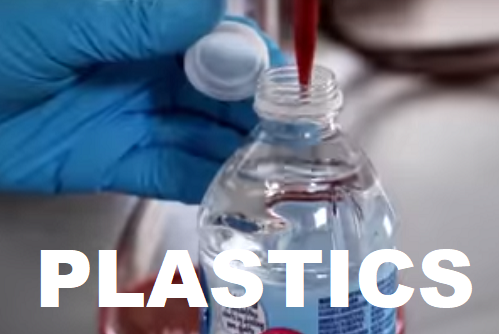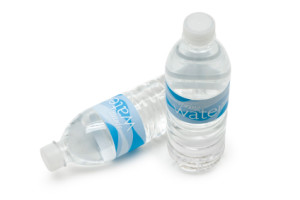A Full Description of Plastics, and What Kinds of Plastics are Safe to Store Ionized Water
Published by Alkaline Water Plus
Many people have been concerned with plastics lately. The facts are that our lives are at this point dependendent on plastic! I’ve developed a chart, below, to help you determine whether the plastic you’re using is safe to use or not. More information about problems with plastics can be found on my Bottled Water page.
What are Plastics?
Plastics are material made from resins. Resins are sticky substances composed primarily of hydro-carbons that either come from plant sources [like the sap of a tree] or are made synthetically. They’re sticky when in their liquid state and they are transparent when they harden. Synthetic plastics are usually made with petroleum-based chemicals.
What do plastics have to do with water ionizers?
Good question. Many people drink their ionized water from plastic bottles or store them in plastic pitchers. Also, water ionizers have tubing made of plastic for the transport of water from the tap to and through the water ionizer.
We Only Use SAFE PLASTICS.
At Alkaline Water Plus we only sell water ionizers that use safe plastics. We make it a point to check this out as part of our thorough research about a water ionizer.
Make sure to use safe plastics for storing ionized water (if you choose a plastic container). We invite you to read our articles about the best containers for storing ionized water. We have found no plastics are effective in preserving ionization.
What are unsafe plastics?
If used properly most plastics have been deemed safe, however for food storage or anything involving human consumption there are potential risks of leaching hazardous chemicals into the foods from plastics. In particular, the hazards increase whenever you are heating the plastics.
Here is a good quote from WebMD.com:
“Virtually all food packaging materials contain substances that can migrate into the food they contact. Heating food in plastic seems to increase the amount that’s transferred to food. Migration also increases when plastic touches fatty, salty, or acidic foods.”
Some plastics are riskier than others, because of the chemicals used to make that particular plastic. I have organized the rest of this article around describing the different kinds of plastics, their safe uses, and their application to drinking ionized water.
Tips for Using and Cleaning Plastics Safely [Sanitary & Toxin-Free]
- Wash them with only mild detergents, and don’t scrub.
- Rinse them with clean water and then soak them in low-pH, acidic, water for sanitation.
- Don’t heat food in containers, baggies, or cling-wrap made of plastics.
- Only use #1, #2, #4, and #5 plastics for food storage unless the container has a NSF seal or otherwise is certified to be food-grade.
- Use glass rather than plastic for food and water storage whenever you can.
- Discard plastic containers that appear damaged, scratched, discolored or old. [Recycle them if possible though.]
- [As a side note, specific warnings have been made against the storage of *acidic foods or beverages in plastic containers.]
Types of Plastics and Their Safety to Use
| Material |
Recycle # |
Safe for Water? |
| PET |
1 |
Yes |
| HDPE |
2 |
Yes |
|
PVC
CPVC |
3 none |
No Yes |
| LDPE |
4 |
Yes |
| PP |
5 |
Yes |
| PS |
6 |
No |
| PC |
7 |
Make sure it’s BPA Free |
| ABS |
7 |
Yes |
| SAN |
7 |
Yes |
#1 PET
#1 PET [or PETE], polyethylene terephthalate, is thin, lightweight, strong and clear. It is deemed safe for storing liquids. Plastic bottles made of PET are not recommended for reuse, because not enough studies have been done to determine the safety of reusing these bottles. They wrinkle and scratch and can harbor bacteria. They can’t be cleaned in hot water, and so cleaning them properly may be difficult. I suggest if you reuse a PET bottle, that you frequently rinse it out well and then soak it in a bucket of 3-pH, or below, acidic water for over a minute. I don’t suggest using PET bottles for storing ionized water, because they are porous to gasses and the ORP will dissipate quickly. However for pouring and drinking all in a short, hour or less, period of time they are fine. PET is easy to recycle.
FDA approved uses for PET bottles include: soft drinks, water, other drinks, ketchup, jelly, peanut butter and salad dressing.
#2 HDPE
#2 HDPE (high density polyethylene) are opaque and strong. HDPE is good for storing water, because it isn’t known to leach chemicals. It is harder and less porous than PET, but still more porous than glass [which is the preferred material for storing ionized water long-term [over an hour]. HDPE is also easy to recycle.
FDA approved uses for HDPE are in milk, juice, yogurt, margarine and water containers. HDPE is also used in grocery bags and cereal box liners. Because of its safety features it’s also used for storage of chemicals and detergents.
#3 PVC
#3 PVC, Polyvinyl chloride, is not safe for water storage. The potential of leaching toxins [i.e., DEHA, Lead, dioxin…] into the food or water stored is high. Some cling-wrap is made from PVC. You should never microwave food wrapped in cling-wrap or in a PVC, #3, container. PVC containers are not easily recycled because of the danger described here.
FDA approved uses for PVC are plastic food wrap and shrink wrap, containers for cooking oil and peanut butter. Other non-food uses include: vinyl pipes, shower curtains, flooring, and siding.
CPVC: Don’t confuse PVC with CPVC. CPVC has been approved for use in household water-lines, and is considered safe for use with water supply or storage. CPVC is not recyclable.
#4 LDPE
#4 LDPE, low-density polyethylene, is not particularly unsafe, but is not the usual choice for water supply or storage. Its common use is with bread bags or other food bags, grocery bags, some shrink wraps, and with squeeze bottles. It’s not known to leach chemicals. It is difficult to recycle.
FDA approved uses for LDPE are plastic bags, food storage, bread bags, frozen food bags, some food wraps, and squeeze-bottles.
#5 PP
#5 PP, polypropylene, is strong and not known to leach chemicals, and is safe for food storage. PP plastics are not as easily recycled as the PET or HDPE, above.
FDA approved uses for PP plastics are: All food containers, even the ones used for more difficult tasks, such as filling with hot liquid, and making caps/lids that have to screw precisely onto a jar. PP is also used for making containers that need to be heated or incubated, such as yogurt. PP is also approved for use in take-out food containers and drinking straws
#6 PS
#6 PS, polystyrene, is either rigid and strong or can be expanded [EPS] to have a foamy quality. PS containers should not be used for storing ionized water. It uses toxic, cancer-causing agents in production, and so can’t be recycled.
FDA approved uses for PS plastics are: egg cartons, meat trays, disposable coffee cups and some tableware. Other, non-food, uses are plastic foam, packing peanuts, hangers.
#7 Other
#7, Other-Plastics (usually polycarbonate) are plastics made from several types of resins mixed together or less common types of resins. They can’t be recycled. I’ve listed several plastics in this category, below.
PC, Polycarbonates, listed as #7 plastics. They are a clear, strong plastic. They are potentially hazardous if they are not labeled “BPA-free”.
FDA approved uses for polycarbonates are: baby bottles, microwave ovenware, restaurant food storage containers, eating utensils, plastic coating for metal cans, although the caveat is to watch for the “BPA-free” label if you’re buying these things. BPA, biphenyl-A, was developed as a form of synthetic estrogen. It disrupts hormones and can stimulate breast cancer.
SAN, styrene acrylonitrile, is good, because it has greater heat-resistance. SAN is labeled #7, but unlike polycarbonates, there is no known concern about leaching toxins. SAN plastics are considered safe for use with water storage. Frequently water pitchers are made with SAN.
Acrylics: BPA-free acrylic plastic dinnerware is also labled #7. These are considered safe.
What is BPA?
Buyer beware! Among the list of plastics made from polycarbonates, and therefore at risk of containing BPA, are water bottles!
BPA is a byproduct-chemical released from certain plastics [called polycarbonates], and has been found to be unsafe. Studies have linked it with hormone disruption in mice and monkeys. Horemones, like estrogen, are necessary to stay in balance for many health reasons. There are also claims of potential risks for diabetes, liver damage, and heart disease. Not all polycarbonates are unsafe. Some are labled “BPA Free”, and are considered safe. You can tell if a plastic is made of polycarbonates by the label. The abbreviation, PC, will indicate that the plastic is a polycarbonate. PC is labeled with recycling #7, but not all #7 plastics are PC [see #7, above].
Who Evaluates Plastics?
FDA Approved Plastic Materials
FDA (Food & Drug Administration): The FDA does not give blanket approval to anything. It gives guidelines for using plastics safely. The uses are outlined in this article. .
NSF Approved Plastic Materials
NSF (National Sanitation Foundation) sets standards for safety and offer certification. Products can be certified by NSF as “safe”. Look for the NSF symbol on the product or packaging.
Plastics Recycling Numbers
The numbers on the bottom of a plastic container, surrounded by a recycling triangle, represent the type of resin used to make that particular plastic. Some numbers represent plastics that are not good for recycling, because those resins get permanently changed in the production process and therefore the plastic cannot easily be re-formed into something else. Some resins are a greater health risk than others.
Read more about my water ionizer comparisons and tips to best use of a water ionizer.



